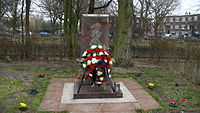Khojaly Massacre
| Khojaly Massacre | |
|---|---|
| Part of the Nagorno-Karabakh War | |

Khojaly Massacre Memorial in The Hague, Netherlands.
|
|
| Location |
Khojaly, Azerbaijan disputed with the Nagorno-Karabakh Republic |
| Coordinates | 39°54′40″N 46°47′21″E / 39.91111°N 46.78917°ECoordinates: 39°54′40″N 46°47′21″E / 39.91111°N 46.78917°E |
| Date | 25–26 February 1992 |
| Target | Azerbaijani residents |
| Deaths | 161+ or 200+ (Human Rights Watch) 485 (Azerbaijani parliament figure) 613 (Azerbaijani government claim) |
| Chodschali-Denkmal in Berlin | |
 |
|
| Location | Zehlendorf, Berlin, Germany |
|---|---|
| Designer | Akif Asgarov Salehab Mammadov Ali Ibadullayev Ebrahim Ehrari |
| Type | Memorial |
| Height | 2 m |
| Completion date | 2011 |
| Opening date |
30 May 2011 |
| Restored date | |
| Dedicated to | Victims of the Khojaly Massacre |
The Khojaly Massacre, also known as the Khojaly tragedy, was the killing of at least 161 ethnic Azerbaijani civilians from the town of Khojaly on 25–26 February 1992 by the Armenian and, partially, by CIS armed forces during the Nagorno-Karabakh War. According to the Azerbaijani side, as well as Memorial Human Rights Center, Human Rights Watch and other international observers, the massacre was committed by the ethnic Armenian armed forces, reportedly with help of some military personnel of the 366th CIS regiment, apparently not acting on orders from the command. The death toll claimed by Azerbaijani authorities is 613 civilians, including 106 women and 63 children. The event became the largest massacre in the course of Nagorno-Karabakh conflict.
Western governments and the western media refer to it as the "Khojaly massacre", "Khojaly tragedy" or the "Battle for Khojaly". Azerbaijani sources occasionally refer to the massacre as "Khojaly genocide" (Azerbaijani: Xocalı soyqırımı) and the "Khojaly tragedy" (Azerbaijani: Xocalı faciəsi).
During the Nagorno-Karabakh conflict, both Armenians and Azerbaijanis became victims of pogroms and ethnic cleansing, which resulted in numerous casualties and displacement of large groups of people. By 1992 the conflict had escalated into a full-scale war. In February 1992 the capital of Karabakh, Stepanakert, was under a blockade and constant bombardment by Azerbaijani forces.
The town of Khojaly was on the road from Shusha and Stepanakert to Agdam and had the region's only airport. The airport was of vital importance for the survival of the population in Karabakh, which had no land connection with the Republic of Armenia and was under a total blockade by Azerbaijan. According to reports from Human Rights Watch, Khojaly was used as a base for Azerbaijani forces shelling the city of Stepanakert. The indiscriminate shelling and sniper shooting killed or maimed hundreds of civilians, destroyed homes, hospitals and other objects that are not legitimate military targets, and generally terrorized the civilian population. Khojaly was shelled by Armenian forces almost daily during the winter of 1991–1992, and people grew accustomed to spending nights in basements. During the winter of 1992, Armenian forces went on the offensive, forcing almost the entire Azerbaijani population of the enclave to flee, and committing what HRW describes as "unconscionable acts of violence against civilians" as they fled. In 1988 the town had 2,135 inhabitants. Due to the Nagorno-Karabakh War and the population exchanges between Armenia and Azerbaijan, and Meskhetian Turk refugees leaving Central Asia and subsequently settling in Khojaly, this number had grown to about 6,000 by 1991.
...
Wikipedia
